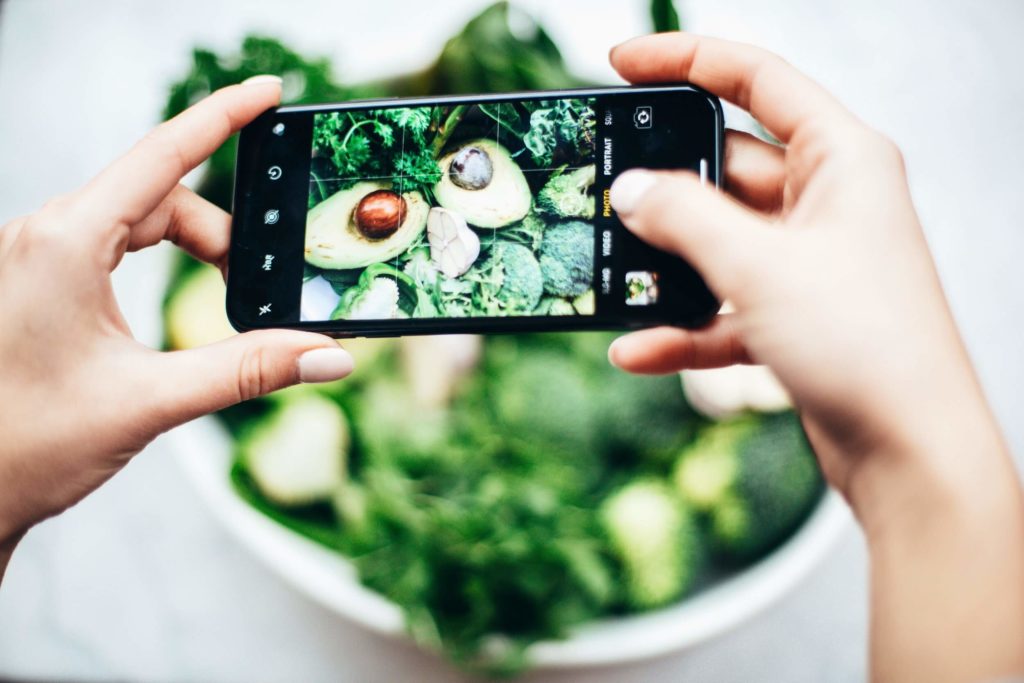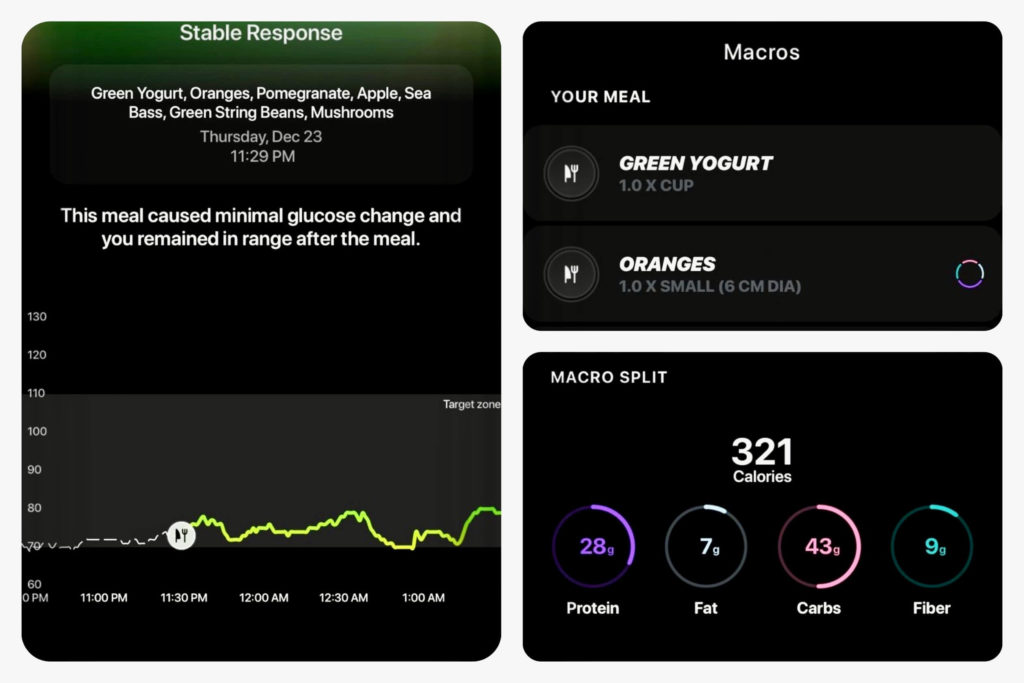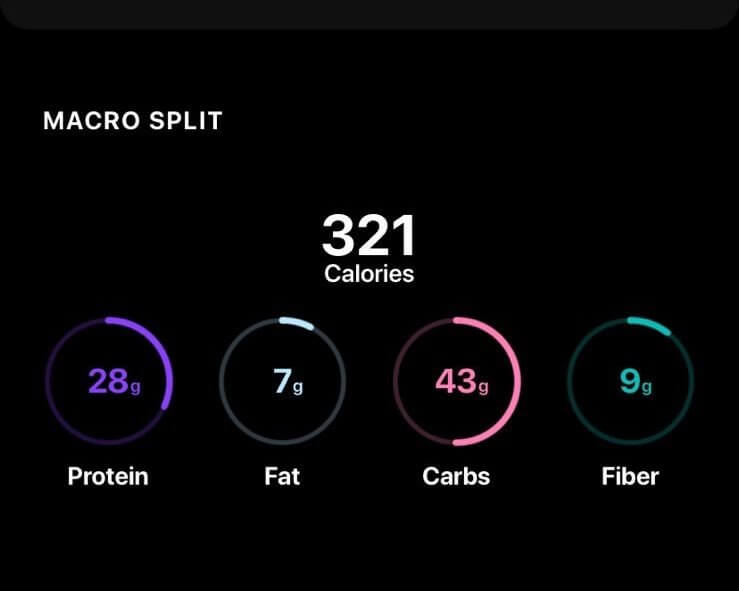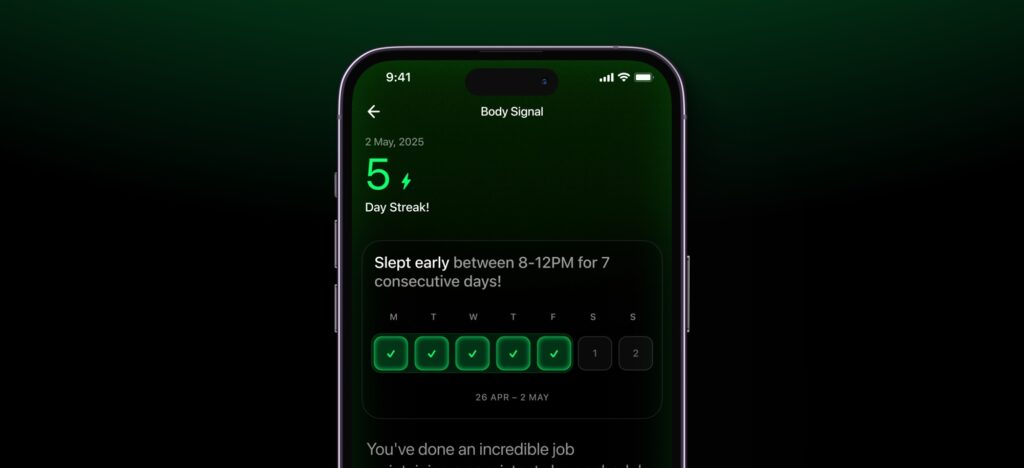Eating healthy can be a Herculean task for some people. Whether you want to cut back on sugar or reduce your portion size, figuring out where to start and what to do can be overwhelming. This is not a one size fits all approach and an ‘ideal diet’ is a fallacy. Personalised food choices are at the heart of metabolic health. Knowing what works for your body is the best way forward. Logging your food digitally and receiving insights with the use of a continuous glucose monitor (CGM) is one way to kickstart the habit of eating right.

Highlights
- Food logging is a tool to help you track the food and beverages you consume in a day with the time of their intake,
- Meticulous food logging can help you understand the breakup of the macronutrients consumed,
- Our algorithms constantly help you optimise the impact of food and drinks on your body. The food score monitors the impact of food and beverages on your blood sugar 2 hours after you have consumed them.
What is food logging?
Keeping a record of your dietary patterns is often suggested by doctors, dieticians and nutritionists as a means to understand eating habits and make relevant changes that correspond with your health goals. Food logging is a tool to help you keep track of all the food and beverages you eat/drink in a day and the time at which they are consumed.
How do you do it?
The simplest way to log your food is by inputting the following details:
1. What you ate
Type in the food you eat. This doesn’t mean you just mention the meal. Break it down and enter each item consumed. For instance, if you ate a chicken breast and rice with sauteed vegetables, make sure to include the names of the vegetables and the kind of rice you ate. Each vegetable will make for a different calorie count. Meticulous food logging can help you understand the breakup of the macronutrients consumed. Carbohydrates, fat and proteins comprise the former while the latter are smaller nutrition categories like vitamins and minerals.
2. How much you ate
Note the quantity of what you ate using any measurement scale you prefer. For instance, if you ate a chicken breast and rice with sauteed vegetables, make sure to log in how much chicken you had – say 100 gms, the quantity of rice you ate – say one cup of rice and the portion of each of the vegetables – for instance, 20 gms carrot, 25 grams broccoli and 30 gms zucchini. This will help you get an accurate calorie count and nutrient analysis.
3. What time you ate
Try to input the details in real time without too much delay. This will help you keep track of the timing at which you ate certain foods. This will not only help you build consistency in your food timings but also reveal how the same foods consumed at different times can yield different results. For example, you may find that eating a dessert after your meal may not lead to blood sugar spikes but eating a sweet breakfast may increase your blood sugar.
Most CGM applications, including Ultrahuman, allow you to document this information with great ease.
Food logging with the Ultrahuman Cyborg
Food logging is one of the fundamental inputs that the Ultrahuman app asks you to provide. Our algorithms constantly help you optimise the impact of food and drinks on your body. This Ultrahuman Cyborg calculates a food score based on the glucose peak (highest glucose point in the 2 hour food intake window), glucose change caused by the food and Time over the Target during the food time window. The food score monitors the effect of food and beverages 2 hours after you have consumed them. It then produces a score ranging from 0-10. The lower these metrics are, the better your food score is. Understanding this score will help you understand how your food impacts your metabolism. A food score of 9 or 10 suggests that the corresponding food or beverage is good for your metabolic health. If the score is somewhere on the scale of 6 to 8, then you need to experiment with the food or beverage a little more, possibly decreasing the portion or changing the timing of food or beverage intake will help. A food score lower than 5 elicits an unfavourable high glycemic response. Avoiding such food is best for your metabolic health.

Benefits of food logging with a CGM device
Regular logging of your food has multiple advantages such as:
1. Amp up your nutrition game
The CGM insights double up as a digital food journal. Your body needs a balanced mix of the macronutrients. Our food logging algorithm reveals your macronutrient split and total calorie intake so that you can make dietary changes accordingly. If you work out or have any deficiencies, this nutrient review assumes significance. It helps you make decisions like increasing your fibre intake or reducing your carb consumption. Logging your food intake can help you stay within the macro range you’ve set for yourself.
The CGM will give you insights into your glucose trends by unravelling data about the food that makes your blood glucose crash or surge. It is also helpful in busting myths about so-called healthy foods. While some foods are hailed as nutritious, they may not interact agreeably with your blood glucose. Real-time actionable insights can help you cut back on foods that are not aligned with your metabolic health. Here’s an example – you may think that using a sugar-free creamer with your coffee is a wise choice but you may be unaware that it’s spiking your blood sugar.
You may find your blood sugar dipping or soaring in response to some exercises allowing you to gauge if you were well-fuelled before your workouts. You can decide to include more chicken or full-fat yoghurt, for instance if you are consuming fewer proteins and consume a banana before your workout to fuel it aptly.
2. Mindful eating
Mindful eating or eating food in response to the physical cue of hunger (as opposed to eating beyond satiety levels) aids in building a healthy relationship with food. Research also suggests that it lowers blood sugar levels. (17) The CGM can help you become increasingly aware of how your body responds to food. This data can help you to build more discipline in your life. Visually being able to see the direct impact of food on your blood glucose can help to strengthen the correlation between the particular food and its metabolic impact. If you tend to eat more while sitting in front of the TV every night at a designated time, your food score may reveal its effects. You could accordingly decide to eliminate distractions and eat mindfully and see the results. If you are eating food that isn’t metabolising well, the cyborg will show you your food score and you can then decide to switch what you eat.
3. Weight control
Tracking your food and beverage intake will reveal all the unhealthy habits that are preventing you from either losing or gaining weight. A study including 142 people with obesity revealed that by keeping a log of their food consistently for 6 months, they were able to shed about 10 percent of their weight. You can also use the macronutrient split to strategise. For instance, if you are trying to gain weight and your macronutrients split shows that you are consuming fewer proteins and carbohydrates, you can start to include more lean meat and rice into your diet.
4. Pre-planning
If you ate a meal that has a food score of 9, you can use that macronutrient split to plan other meals. If the split shows that you consumed 100 gms of protein, you can plan your next few meals with different types of proteins in similar quantities such as fish and chicken. It is important to closely monitor your food score even when you change the source of protein because each food type yields a different quantity of protein. If you tend to feel famished at the end of a workout and end up making poor food choices, a food log will reveal this pattern and you accordingly stock your kitchen with healthier alternatives.
5. Building healthy habits
Food logging helps you become more aware of your eating habits. It especially helps to identify unhealthy eating choices and helps swap these habits for more desirable ones. For instance, you’ll notice the time of the day you tend to feel hungry and snack mindlessly. With the cyborg, you’ll be able to preempt your glucose dips. You could stock your pantry accordingly and decide to eat a fruit to prevent overeating at a later stage.
6. Identifying food sensitivities
Do you often feel lethargic or bloated? Food logging to the rescue. Although this isn’t a direct metric that the cyborg provides, logging your food in the app can help you identify food sensitivities. Writing down what you consume consistently on a daily basis can help you understand the food that doesn’t bode well for your body. A lot of elimination diets (diets that focus on removing allergens) are a byproduct of food journaling and help improve the functioning of your digestive system.
Additionally, if you already have pre-existing illnesses such as Irritable Bowel Syndrome (IBS), certain food can trigger or exacerbate the condition. Logging your food can help prevent adverse reactions and improve your health.
7. Getting the real picture
You may sometimes be under the impression that you’re eating fewer calories in a day. However, once you track your consumption, the opposite may be true. Documenting your food will help you reach your goal by matching your reality with your perceptions and changing those for the better. It will also help you get an accurate macronutrient count. For instance, if you eat 100 gms of paneer, it doesn’t mean that the amount of protein you are deriving from it is 100gms. You may only get 14gms of protein from the 100 grams of paneer consumed. Food logging will help you get a real picture of your nutrient composition.
8. Portion control
Controlling your portion size, especially when you step out to eat, can be cumbersome. Food logging can remind you ‘how much’ you should be eating of a particular food. Again, this isn’t a direct metric provided by the CGM but your ideal food score can serve as a guide. It now means that you can step out and decide to order food that serves up the right macronutrient mix for you.
9. Identifying triggers of unhealthy eating
Looking at your glucose patterns can help you determine a correlation between eating and glucose changes. This will help you fuel your body at the right time and help you make better, more informed food choices in similar situations in the future. If, for instance, you eat more processed food on stressful work days, your food logs will reflect this tendency and its effects. This may compel you to deal with stress in healthier ways or identify the stressor.
10. Accountability
Tracking your food and drinks intake makes you stop and rethink your choices. Every time you have to enter an unhealthy food item or large food portions into your food logs, you’ll begin to hesitate to put it down. This will further prevent you from trying to eat unhealthy foods altogether. The food score helps you understand the food you’ve eaten and tracking the unhealthy meals will motivate you to achieve the ideal food score. Additionally, the food log acts as a motivation for people to stay on track with their nutrition plan.
The purpose of food logging is to encourage you to be more mindful about your diet. If it’s making you anxious, it’s time to step back and take stock. If you have any food disorders, consult a doctor before considering food logging.
Conclusion
Eating healthy is not a one-size-fits all approach. Personalised food choices can aid in meeting your health goals. CGM applications help you to document your food/drink consumption through food logging. Details about what you ate, how much you ate and when you ate need to be entered to understand the impact of different foods on your blood glucose. The CGM generates a food score based on your daily consumption inputs. A higher score suggests that the food is metabolised well and you are optimally fuelled. It helps you understand the impact of your eating patterns on your body in real time. It also helps you identify the macro split of your diet. The benefits of food logging include mindful eating, weight management, identifying triggers of unhealthy eating, eating mindfully and identifying food sensitivities. It’s important to be specific about the details of your consumption. It’s also imperative to understand that the intent of food journaling is to help you establish a healthier relationship with food.
Disclaimer: The contents of this article are for general information and educational purposes only. It neither provides any medical advice nor intends to substitute professional medical opinion on the treatment, diagnosis, prevention or alleviation of any disease, disorder or disability. Always consult with your doctor or qualified healthcare professional about your health condition and/or concerns and before undertaking a new health care regimen including making any dietary or lifestyle changes.
References
- https://familydoctor.org/nutrition-keeping-a-food-diary/#:~:text=A%20food%20diary%20is%20a,diet%20to%20improve%20your%20weight
- https://www.healthline.com/nutrition/food-journaling-instructions-and-tips
- https://www.beebehealthcare.org/health-hub/nutrition/benefits-food-journaling
- https://healthyeating.sfgate.com/benefits-food-diary-7685.html
- https://www.qardio.com/healthy-heart-blog/food-journal/







